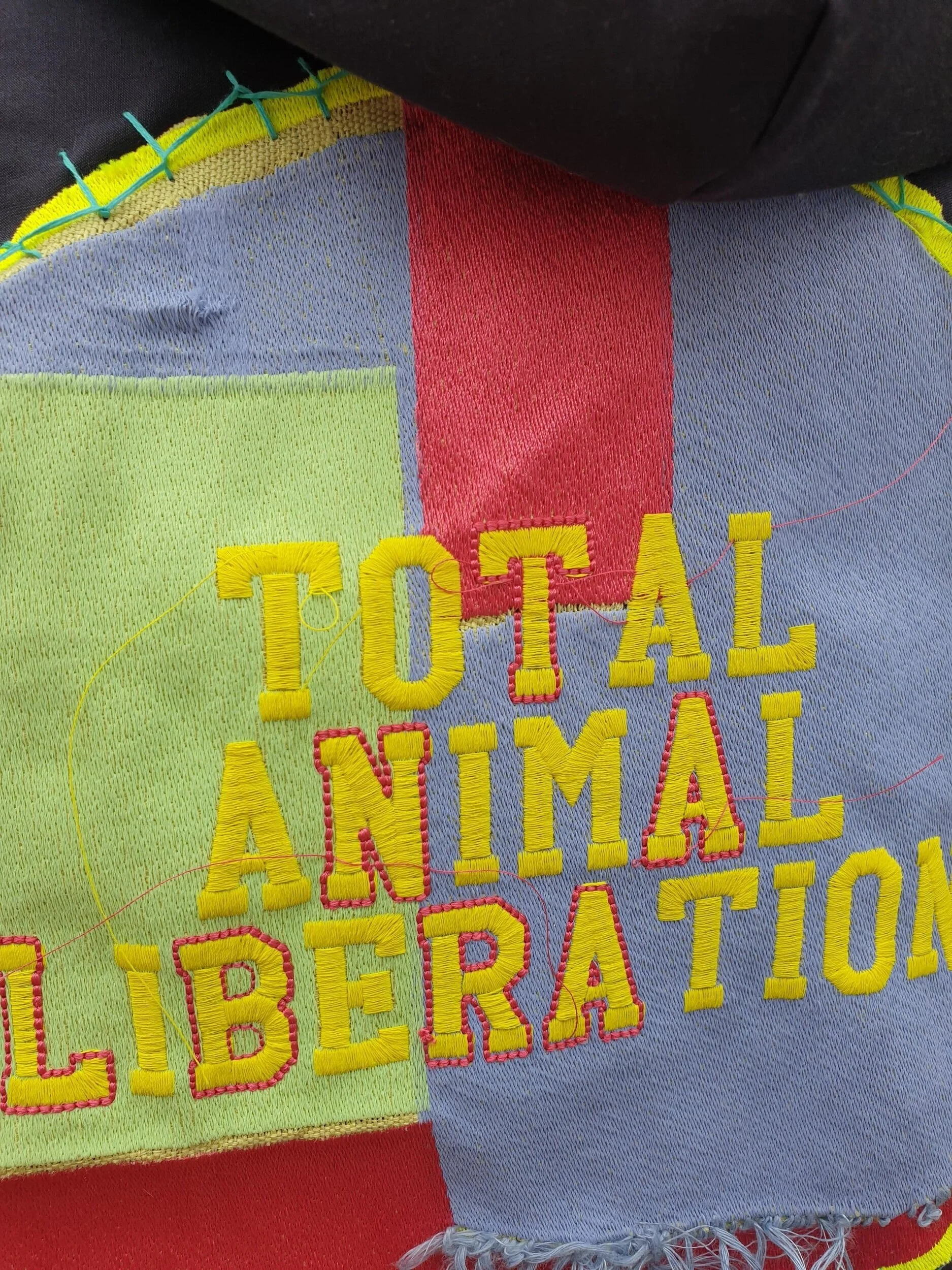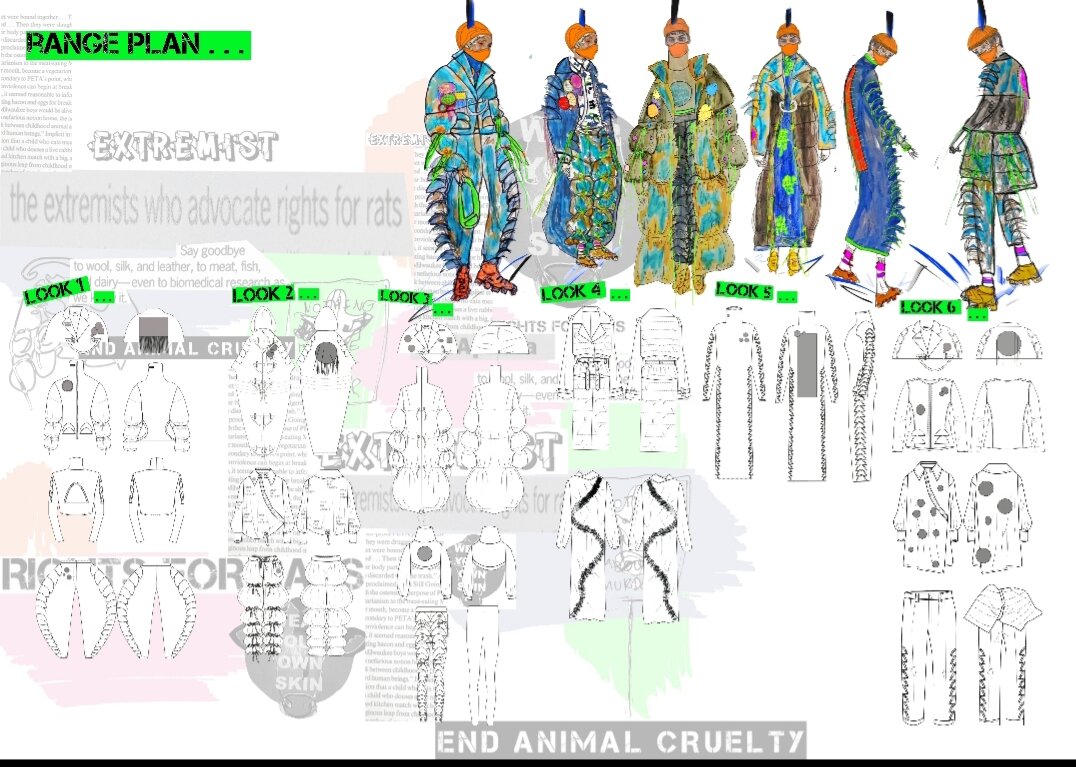Harriet Kate Slavin
Meet GFF Talent Harriet Kate Slavin, a fashion design and textiles graduate at the University of Huddersfield. A passionate vegan and animal rights activist, Harriet’s final year project is inspired by her values. Read more about Harriet’s work and her plans for the future below.
What is the most valuable thing you have learnt at university?
The most valuable thing I've learned at university is not letting my individual style change, since the first year I was always encouraged to embrace individuality and embrace the way I design, no matter how unorthodox or - in my case- messy - it is.
What was the starting point of inspiration for your final project?
My collection had a very certain idea, but the starting point was very unclear. I am a keen animal activist, a vegan for the past couple of years and a vegetarian long before then. I always knew that my final collection would be a protest collection. Giving a voice to voiceless on a platform animal rights are not highly projected on. However, making this a reality brought me to a halt. Having a clear image of the outcome in my head but no research was troubling me. After spending 3 days walking around London, museum after exhibition etc, I found out that the National History Museum houses laboratories dedicated to dead animals.
The animals in these science labs were all animals killed for science and research, each one preserved in a nitrogen solution so it can be studied for years to come. This lab had creatures that had been killed from as early as the 1800s. After studying each animal and taking lots of pictures I decided this was my starting point. These animals completely juxtaposed my beliefs yet simultaneously were a perfect example of my cause. These animals show animal cruelty from a different perspective whilst offering alternative silhouettes and sharp details.
Now that I had found my main research point I began researching the bit that excited me most – the protest. I researched past protests, punk culture, activism and even got in touch with groups such as Anonymous for the voiceless. One protest in particular was the PETA: FOR KIDS patches- these offer ‘to the point’ slogans and images but without doing it in an intimidating way- a tactic that was proved unpopular in the animal rights activism front. All of these prepared me to start making and designing my own protest collection.
What form will your final project take?
My collection will take the physical form of 3 final outfits- each outfit consisting of 3 or 4 garments. Backing this is a portfolio and a sketchbook heaving with ideas. My collection is an autumn/winter 2020, womenswear collection. I have infused my love for street style with my love for classic tailoring. My collection consists of huge of the body style pieces, baggy trousers with lots of pocket details all strategically placed to give a certain resemblance to the creatures that I photographed originally. The silhouettes are bubbly, big and detailed, all done from creative pattern cutting and lots of toiling. Each garment will have some of my protest on – created through lots of textile samples and research.
The protest will be primarily made from AMAYA embroidery patches, hand embroidery and pin badges. There will also be an aspect of print – done in very unconventional methods. All the printing within my collection has been done using gloss wall paint and a hand made stencil. Each piece has been hand printed then heat pressed to ensure the print will stay on. I have re-looked classic pieces such as the classic cotton poplin shit, the classic cape and ‘Puffa’ style coat. Through creative pattern cutting I have re-done these pieces in a more unconventional – contemporary way. This collections focus is the protest, although silhouette is extremely important, I don’t want it to take all the focus of the protest, and vice-versa. So each protest piece is strategically placed to not draw attention away from the silhouette, but make it unmissable to not look at the protest.
What materials have you used and how did you source them?
As a designer I am extremely passionate about sustainability and the ethical sourcing of fabric. I believe that as a designer we have a moral responsibility to be designing for a better and improved future. This being said, trying to source a vegan fabric that is also kind to the planet is incredibly difficult (especially without thousands of pounds in the bank). I took to deadstock sourcing of fabrics for my collection – every fabric I used to make my collection is deadstock all sourced from ‘Fabworks Mill’ a deadstock mill in Dewsbury.
All fabrics used in my collection have no trace of animal products in them, making it 100% suitable for vegans. Furthermore, all the fabrics used for my embroidery patches are from scrap bins left from other peoples projects at my university or from my scrap bins I keep at home. Fastenings and hardware are all from my local market, therefore, supporting a small business. The paint used for printing is leftover paint from decorating my house also. Embroidery threads were all shared with other students using them – therefore creating no wastage.
How has it evolved from your initial ideas and what have you learnt along the way?
My collection has been on a massive journey, just as much of the journey I have been on whilst doing this. So many things changed after sampling, toiling and fitting. My original ideas were very sleek and tailored with a clean message on them. However, after lots of research and sampling my collection naturally fell down a ‘messier’ ‘D.I.Y’ style route. I let my collection evolve naturally without restricting my ideas at all. I never gave myself a cut of point with creativity as I believe my best results come naturally. I kept making things bigger and better slowly giving this classic tailored collection more edge, and more of a streetwear vibe to it, which in the end was definitely the best thing I could have done.
This last year at university – creating this collection has taught me a lot. The main lesson I’ve learned whilst creating this collection was to trust myself. Not giving myself any boundaries and letting my creativity spiral is a good thing. I realised that you can never have too many ideas – despite what I may have been told – I believe I got the best possible outcome (given the COVID -19 circumstances) because I just let my creativity flow. I was changing designs, placement of pockets, seams etc as I was sewing them together. I was always doing small samples that I had not originally toiled to test new ideas. This journey has thought me that doing this is my learning strategy, its how I get my best results.
What are the messages and themes behind your project that you want people to take away? Do explore any topics like diversity, sustainability or politics in your work?
My project has a very clear message. I explore animal rights in depth. My collections main aim is to give a voice to voiceless, but without doing it in an intimidating way. From feedback I have seen in the activist world being upfront with, to most people, a very uncomfortable topic makes people not want to listen and in some cases be actively defiant to the cause. This is why I am trying to get the message across in a kinder, less vigil way. As a person and designer animal rights are something I hold very close to me and always have, this is why I think my collection has turned out the way it has because I have never lost interest.
Creating a whole project on something I am so passionate about has made my collection better and I think my passion shows through. The animal rights movement is something, especially in the fashion industry, that is starting to peep through. People are becoming a lot more knowledgeable about animal rights, more sustainable in how they live and more ethical and thoughtful in where they purchase their clothes. Vegan ranges have started popping up all over the place now, however the reason as to why their vegan is not made entirely clear. Many people believe that it is just a fad, my collections aim is to inform people of why veganism and activism exist. In my initial research I look at animal rights from a political, personal and humanitarian point of view. I explore the many different types of injustice in the animal world.
What’s an aspect of the fashion industry that you’re passionate about fixing or having a positive impact on?
The fashion industry to me has many issues. I aim to improve the issues with sustainability, and obviously, animal rights. The use of animal products in fashion is something people don’t always see as an issue, however, there are many cruel practices, unnecessary practices and sustainability issues within this. Animal products, particularly leather is extremely polluting. In fact, it is one of the most polluting sub-sectors of the fashion industry. Leather is responsible for the presence of sulphide, ammonia and other volatile compounds.
Not only this but most leather is produced from tanneries in countries like India and with little-to-no protective equipment, workers are dealing with extremely positions chemicals all the time, putting workers at risk. I pride myself on my ethical values and believe that by educating people on the issues at a way that suits them best is the first and best way into fixing these problems. The fashion industry has a long way to go, however I believe that designing and creating for a more positive, sustainable future is the best way to do it.
What is your plan once you finish your BA?
There is a lot of uncertainty in terms of what happens next for us 2020 graduates. However my next step ideally is to start my own label on the side of working in the fashion industry as a designer.









